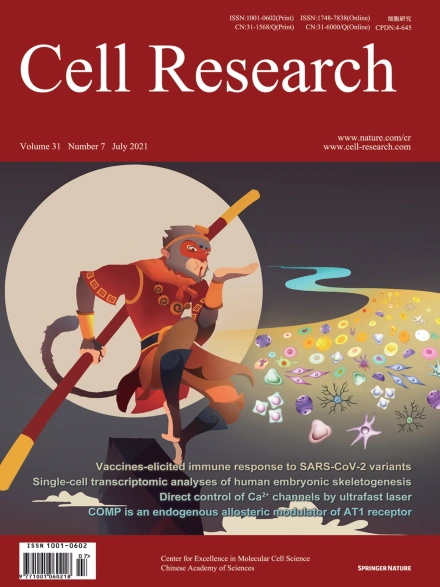
Advanced Search
Submit Manuscript
Advanced Search
Submit Manuscript
Volume 31, No 7, Jul 2021
ISSN: 1001-0602
EISSN: 1748-7838 2018
impact factor 17.848*
(Clarivate Analytics, 2019)
Volume 31 Issue 7, July 2021: 773-790 |
Cartilage oligomeric matrix protein is an endogenous β-arrestin-2-selective allosteric modulator of AT1 receptor counteracting vascular injury
Yi Fu1 , Yaqian Huang1,2 , Zhao Yang3 , Yufei Chen1 , Jingang Zheng4 , Chenfeng Mao1 , Zhiqing Li1 , Zhixin Liu3 , Bing Yu1 , Tuoyi Li1 , Meili Wang1 , Chanjuan Xu5 , Yiwei Zhou5 , Guizhen Zhao1 , Yiting Jia1 , Wei Guo6 , Xin Jia6 , Tao Zhang6 , Li Li7 , Ziyi Liu1 , Shengchao Guo3 , Mingliang Ma3 , Heng Zhang1 , Bo Liu1 , Junbao Du2 , Wengong Wang8 , Chaoshu Tang1 , Pei Gao9 , Qingbo Xu10 , Xian Wang1 , Jianfeng Liu5 , Jinpeng Sun1,3,* , Wei Kong1,*
1Department of Physiology and Pathophysiology, School of Basic Medical Sciences, Peking University; Key Laboratory of Molecular Cardiovascular Science, Ministry of Education, Beijing 100191, ChinaCompelling evidence has revealed that biased activation of G protein-coupled receptor (GPCR) signaling, including angiotensin II (AngII) receptor type 1 (AT1) signaling, plays pivotal roles in vascular homeostasis and injury, but whether a clinically relevant endogenous biased antagonism of AT1 signaling exists under physiological and pathophysiological conditions has not been clearly elucidated. Here, we show that an extracellular matrix protein, cartilage oligomeric matrix protein (COMP), acts as an endogenous allosteric biased modulator of the AT1 receptor and its deficiency is clinically associated with abdominal aortic aneurysm (AAA) development. COMP directly interacts with the extracellular N-terminus of the AT1 via its EGF domain and inhibits AT1-β-arrestin-2 signaling, but not Gq or Gi signaling, in a selective manner through allosteric regulation of AT1 intracellular conformational states. COMP deficiency results in activation of AT1a-β-arrestin-2 signaling and subsequent exclusive AAA formation in response to AngII infusion. AAAs in COMP–/– or ApoE–/– mice are rescued by AT1a or β-arrestin-2 deficiency, or the application of a peptidomimetic mimicking the AT1-binding motif of COMP. Explorations of the endogenous biased antagonism of AT1 receptor or other GPCRs may reveal novel therapeutic strategies for cardiovascular diseases.
https://doi.org/10.1038/s41422-020-00464-8